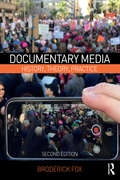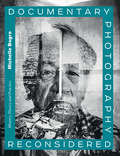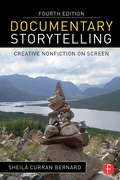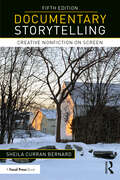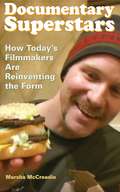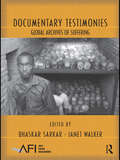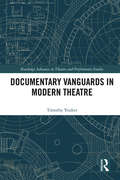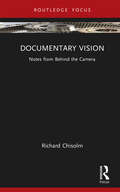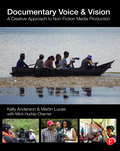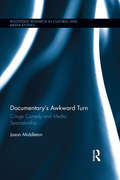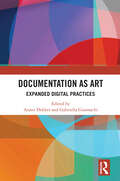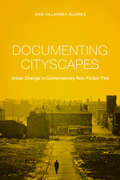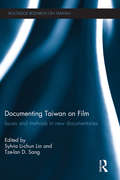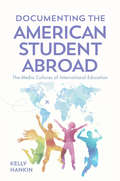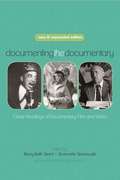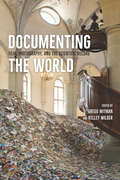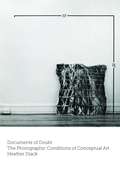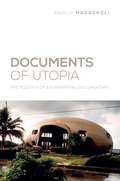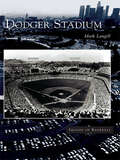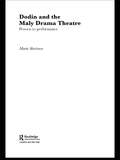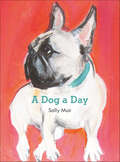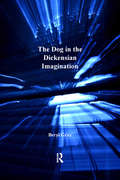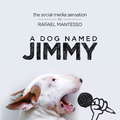- Table View
- List View
Documentary Media: History, Theory, Practice
by Broderick FoxIn a digital moment where both the democratizing and totalitarian possibilities of media are unprecedented, the need for complex, ethical, and imaginative documentary media—for you, the reader of this book to think, question, and create—is vital. Whether you are an aspiring or seasoned practitioner, an activist or community leader, a student or scholar, or simply a curious audience member, author Broderick Fox opens up documentary media, its changing forms, and diversifying social functions to readers in a manner that is at once rigorous, absorbing, and practical. This new edition updates and further explores the various histories, ideas, and cultural debates that surround and shape documentary practice today. Each chapter engages readers by challenging traditional assumptions, posing critical and creative questions, and offering up innovative historical and contemporary examples. Additionally, each chapter closes with an "Into Practice" section that provides analysis and development exercises and hands-on projects that will assist you in generating a full project prospectus, promotional trailer, and web presence for your own documentary.
Documentary Photography Reconsidered: History, Theory and Practice
by Michelle BogreDocumentary photography is undergoing an unprecedented transformation as it adapts to the impact of digital technology, social media and new distribution methods. In this book, photographer and educator Michelle Bogre contextualizes these changes by offering a historical, theoretical and practical perspective on documentary photography from its inception to the present day. Documentary Photography Reconsidered is structured around key concepts, such as the photograph as witness, as evidence, as memory, as narrative and as a vehicle for activism and social change. Chapters include in-depth interviews with some of the world's leading contemporary practitioners, demonstrating the wide variety of different working styles, techniques and topics available to new photographers entering the field. Every key concept is illustrated with work from a range of innovative, influential and often under-represented photographers, giving a flavor of the depth and range of projects from the history of this global art form. There are also creative projects designed to spark ideas and build skills, to help you conceive, develop and produce your own meaningful documentary projects. The book is supported by a companion website, which includes in-depth video interviews with featured practitioners.
Documentary Storytelling: Creative Nonfiction on Screen
by Sheila Curran BernardDocumentary Storytelling has reached filmmakers and filmgoers worldwide with its unique focus on the key ingredient for success in the growing global documentary marketplace: storytelling. This practical guide reveals how today's top filmmakers bring the tools of narrative cinema to the world of nonfiction film and video without sacrificing the rigor and truthfulness that give documentaries their power. The book offers practical advice for producers, directors, editors, cinematographers, writers and others seeking to make ethical and effective films that merge the strengths of visual and aural media with the power of narrative storytelling. In this new, updated edition, Emmy Award-winning author Sheila Curran Bernard offers: New strategies for analyzing documentary work New conversations with filmmakers including Stanley Nelson (The Black Panthers), Kazuhiro Soda (Mental), Orlando von Einsiedel (Virunga), and Cara Mertes (JustFilms) Discussions previously held with Susan Kim (Imaginary Witness), Deborah Scranton (The War Tapes), Alex Gibney (Taxi to the Dark Side), and James Marsh (Man on Wire).
Documentary Storytelling: Creative Nonfiction on Screen
by Sheila Curran BernardFor nearly two decades, Documentary Storytelling has reached filmmakers and filmgoers worldwide with its unique focus on the key ingredient for success in the global documentary marketplace: storytelling. As this revised, updated fifth edition makes clear, nonfiction storytelling is not limited to character-driven journeys, but instead encompasses the diverse ways in which today’s top documentarians reach audiences with content that is creative, original, and often inspirational, all without sacrificing the integrity that gives documentary its power. This book is filled with practical advice for writers, producers, directors, editors, cinematographers, and others committed to reality-based filmmaking that seeks to reach audiences, raise awareness, address social issues, illuminate the human condition, and even entertain. In this new edition, Emmy Award-winning filmmaker and author Sheila Curran Bernard offers: a closer look at the way ethical nonfiction filmmakers take creative, authorial leaps while also remaining transparent with audiences; new tools for understanding how documentaries are structured, how they may rearrange time for storytelling effect, and how a simple narrative throughline can convey complexity without being a conventional "hero’s journey"; new conversations with filmmakers and educators including Dawn Porter, Madison Hamburg, Tracy Heather Strain, June Cross, Heidi Gronauer, and Julie Casper Roth, and another look at conversations with Stanley Nelson and Orlando von Einsiedel. Please visit the book’s website, available at www.documentarystorytelling.com, for further information, related articles, and more.
Documentary Superstars: How Today's Filmmakers Are Reinventing the Form
by Marsha MccreadieMcCreadie (documentary film, Fordham U.) explores changing trends in documentary filmmaking, and notes how current documentarians such as Michael Moore and Morgan Spurlock are becoming "glamorous Hollywood figures." Written for film students and fans of documentaries, this volume profiles leading figures in the field to show how the art form now employs rabble-rousing, charisma, humor and a visionary attitude in order to cross boundaries and become more accessible to mainstream audiences.
Documentary Testimonies: Global Archives of Suffering (AFI Film Readers)
by Bhaskar Sarkar Janet WalkerDocumentary Testimonies examines documentary films that compel us to bear witness, move us to anger or tears, and possibly mobilize us to action. Comprising ten new essays and a substantive introduction, this interdisciplinary volume examines audiovisual testimonial practices, forms, and institutions. Topics include: technologies of capture, storage and circulation; problems of historical veracity/frail memory; generation of video archives--official, renegade, and ephemeral; limits and potentialities of documentary as public record; architectonics of memory; ethics of witnessing and commemoration; human rights and activist publics. The essays provide in-depth analysis of archives of social suffering tied to particular locales: Cambodia, Chiapas, Darfur, India, Indonesia, Korea, New Orleans, Norway, Rwanda, South Africa, and Washington, DC. The contributors focus on the generation and use of testimony by public administrators and institutions, human rights activists, documentary filmmakers, and others with interest in environmental justice, human rights, social advocacy, and the commemoration/prevention of genocide. Thus, this volume aims to investigate, from a critical and translocal perspective, testimony as social practice.
Documentary Vanguards in Modern Theatre (Routledge Advances in Theatre & Performance Studies)
by Timothy YoukerPractitioners and critics alike often attribute great authenticity to documentary theatre, casting it as a salutary alternative not only to corporate news outlets and official histories but also to the supposed "self-indulgence" and "elitism" of avant-garde theatre. Documentary Vanguards in Modern Theatre, by contrast, argues for treating documentarians as vanguardists who (for good or ill) push, remap, or transgress the margins of historical and political visibility, often taking issue with professional discourses that claim a monopoly on authoritative representations of the real. This is the first book to situate documentary theatre’s development within the larger story of theatrical experimentalism, collage art, collective ritual, and other avant-garde dramaturgical and performance practices of the late 19th and 20th Centuries.
Documentary Vision: Notes from Behind the Camera
by Richard ChisolmThis book is a collection of personal essays that address critical elements involved in the production of nonfiction films. Written by an experienced documentary filmmaker and cinematographer, the book draws upon practical wisdom to explore the nuances and challenges faced by filmmakers and viewers alike. Included in the text are rarely discussed ethical issues, best practices in the field, filmmaker etiquette, and a detailed analysis of interview techniques. The book also provides a candid view of how decisions are made in production that are consequential to a finished film’s meaning and fidelity. Drawing on a wide range of subject matter, it will enhance the reader's understanding of the tremendous power and potential of the documentary medium. The book offers an invaluable insight into documentary filmmaking for professionals who work in the medium and students who are learning the trade and honing their skills.
Documentary Voice & Vision: A Creative Approach to Non-Fiction Media Production
by Kelly Anderson Martin LucasLearn the creative and technical essentials of documentary filmmaking with Documentary Voice & Vision. This comprehensive work combines clear, up-to-date technical information, production techniques and gear descriptions with an understanding of how technical choices can create meaning and serve a director’s creative vision. Drawing on the authors’ years of experience as documentary filmmakers, and on interviews with a range of working professionals in the field, the book offers concrete and thoughtful guidance through all stages of production, from finding and researching ideas to production, editing and distribution. Documentary Voice & Vision will help students and aspiring filmmakers think though research and story structure, ethics, legal issues and aesthetics, as well as techniques from camera handling to lighting, sound recording and editing. The book explores a full range of production styles, from expository to impressionistic to observational, and provides an overview of contemporary distribution options. Documentary Voice & Vision is a companion text to Mick Hurbis-Cherrier’s Voice & Vision: A Creative Approach to Narrative Film and DV Production, and employs a similar style and approach to that classic text. This text is written from the perspective of documentary filmmakers, and includes myriad examples from the world of non-fiction filmmaking. A robust companion website featuring additional resources and interactive figures accompanies the book.
Documentary's Awkward Turn: Cringe Comedy and Media Spectatorship (Routledge Research in Cultural and Media Studies)
by Jason MiddletonDespite the prominence of "awkwardness" as cultural buzzword and descriptor of a sub-genre of contemporary film and television comedy, it has yet to be adequately theorized in academic film and media studies. Documentary’s Awkward Turn contributes a new critical paradigm to the field by presenting an analysis of awkward moments in documentary film and other reality-based media formats. It examines difficult and disrupted encounters between social actors on the screen, between filmmaker and subject, and between film and spectator. These encounters are, of course, often inter-connected. Awkward moments occur when an established mode of representation or reception is unexpectedly challenged, stalled, or altered: when an interviewee suddenly confronts the interviewer, when a subject who had been comfortable on camera begins to feel trapped in the frame, when a film perceived as a documentary turns out to be a parodic mockumentary. This book makes visible the ways in which awkwardness connects and subtends a range of transformative textual strategies, political and ethical problematics, and modalities of spectatorship in documentary film and media from the 1970s to the present.
Documentation as Art: Expanded Digital Practices
by Annet Dekker Gabriella GiannachiDocumentation as Art presents documentation as an expanded practice that is radically changing the ways in which to look at, participate in, and generate art. Bringing together expertise from different disciplines, the book provides an in-depth investigation of the development of documentation as a set of production, circulation, and preservation strategies. Illustrating how these are often led by artists, audiences, and museums, the contributions offer new insights into digital art and its history, curation, and preservation, through documentation. Considering documentation as the main method of preserving these art forms, the book analyses how it can address the inherent challenges of capturing live events, visitor experiences, and evolving artworks. Showing how documentation itself can become (part of) an original artwork, the book discusses ways in which these expanded practices can impact the value and experience of the documented event or artwork, giving consideration to how this might affect the traditional authority of the museum as creator of documentation used for future reference, historical relevance, or cultural memory. Documentation as Art demonstrates how the curation and preservation of documentation and the introduction of audience-generated documentation are radically changing exhibition and visiting practices in which documentation is becoming a significant and emergent cultural form in its own right. The book will appeal to researchers and students engaged in the study of museums and curation, art and art history, performance, new media and digital art, library and information science, and conservation.
Documenting Cityscapes
by Iván Villarmea ÁlvarezFilm studies has traditionally addressed the presence of the city in film as an urban text inside a cinematic text, but this approach has recently evolved into the study of cinema as a technology of place. From this perspective, Documenting Cityscapes explores the way the city has been depicted by non-fiction filmmakers since the late 1970s, paying particular attention to three aesthetic tendencies: documentary landscaping, urban self-portraits and metafilmic strategies. Through formal analysis of fifteen works from six different countries, this volume investigates how the rise of subjectivity has helped to develop a kind of gaze that is closer to citizens than to those institutions and corporations responsible for recent major transformations. Thus, Documenting Cityscapes reveals the extent to which cinema has ultimately become an agent of urban change, where certain films not only challenge the most controversial policies of late-capitalism but also are able to produce spatiality themselves.
Documenting Cityscapes: Urban Change in Contemporary Non-Fiction Film (Nonfictions)
by Iván Villarmea ÁlvarezWhile film studies has traditionally treated the presence of the city in film as an urban text operating inside of a cinematic one, this approach has recently evolved into the study of cinema as a technology of place. From this perspective, Documenting Cityscapes explores the way the city has been depicted by nonfiction filmmakers since the late 1970s, paying particular attention to three aesthetic tendencies: documentary landscaping, urban self-portraits, and metafilmic strategies. Through the formal analysis of fifteen works from six different countries, this volume investigates how the rise of subjectivity has helped to develop a kind of gaze that is closer to citizens than to the institutions and corporations responsible for recent major transformations. Documenting Cityscapes therefore reveals the extent to which cinema has become an agent of urban change, in which certain films not only challenge the most controversial policies of late capitalism but also are able to produce spatiality themselves.
Documenting Taiwan on Film: Issues and Methods in New Documentaries (Routledge Research on Taiwan Series)
by Sylvia Li-chun Lin Tze-lan D. SangTo date, there is but a handful of articles on documentary films from Taiwan. This volume seeks to remedy the paucity in this area of research and conduct a systematic analysis of the genre. Each contributor to the volume investigates the various aspects of documentary by focusing on one or two specific films that document social, political and cultural changes in recent Taiwanese history. Since the lifting of martial law, documentary has witnessed a revival in Taiwan, with increasing numbers of young, independent filmmakers covering a wide range of subject matter, in contrast to fiction films, which have been in steady decline in their appeal to local, Taiwanese viewers. These documentaries capture images of Taiwan in its transformation from an agricultural island to a capitalist economy in the global market, as well as from an authoritarian system to democracy. What make these documentaries a unique subject of academic inquiry lies not only in their exploration of local Taiwanese issues but, more importantly, in the contribution they make to the field of non-fiction film studies. As the former third-world countries and Soviet bloc begin to re-examine their past and document social changes on film, the case of Taiwan will undoubtedly become a valuable source of comparison and inspiration. These Taiwanese documentaries introduce a new, Asian perspective to the wealth of Anglo-American scholarship with the potential to serve as exemplar for countries undergoing similar political and social transformations. Documenting Taiwan on Film is essential reading for all those interested in Taiwan Studies, film studies and Asian cinema.
Documenting the American Student Abroad: The Media Cultures of International Education
by Kelly Hankin1 in 10 undergraduates in the US will study abroad. Extolled by students as personally transformative and celebrated in academia for fostering cross-cultural understanding, study abroad is also promoted by the US government as a form of cultural diplomacy and a bridge to future participation in the global marketplace. In Documenting the American Student Abroad, Kelly Hankin explores the documentary media cultures that shape these beliefs, drawing our attention to the broad range of stakeholders and documentary modes involved in defining the core values and practices of study abroad. From study abroad video contests and an F.B.I. produced docudrama about student espionage to reality television inspired educational documentaries and docudramas about Amanda Knox, Hankin shows how the institutional values of “global citizenship,” “intercultural communication,” and “cultural immersion” emerge in contradictory ways through their representation. By bringing study abroad and media studies into conversation with one another, Documenting the American Student Abroad: The Media Cultures of International Education offers a much needed humanist contribution to the field of international education, as well as a unique approach to the growing scholarship on the intersection of media and institutions. As study abroad practitioners and students increase their engagement with moving images and digital environments, the insights of media scholars are essential for helping the field understand how the mediation of study abroad rhetoric shapes rather than reflects the field’s central institutional ideals.
Documenting the Documentary: Close Readings of Documentary Film and Video, New and Expanded Edition
by Barry Keith Grant Jeannette SloniowskiOriginally released in 1998, Documenting the Documentary responded to a scholarly landscape in which documentary film was largely understudied and undervalued aesthetically, and analyzed instead through issues of ethics, politics, and film technology. Editors Barry Keith Grant and Jeannette Sloniowski addressed this gap by presenting a useful survey of the artistic and persuasive aspects of documentary film from a range of critical viewpoints. This new edition of Documenting the Documentary adds five new essays on more recent films in addition to the text of the first edition. Thirty-one film and media scholars, many of them among the most important voices in the area of documentary film, cover the significant developments in the history of documentary filmmaking from Nanook of the North (1922), the first commercially released documentary feature, to contemporary independent film and video productions like Werner Herzog's Grizzly Man (2005) and the controversial Borat (2006). The works discussed also include representative examples of many important national and stylistic movements and various production contexts, from mainstream to avant-garde. In all, this volume offers a series of rich and revealing analyses of those "regimes of truth" that still fascinate filmgoers as much today as they did at the very beginnings of film history. As documentary film and visual media become increasingly important ways for audiences to process news and information, Documenting the Documentary continues to be a vital resource to understanding the genre. Students and teachers of film studies and fans of documentary film will appreciate this expanded classic volume.
Documenting the World: Film, Photography, and the Scientific Record
by Gregg Mitman Kelley WilderImagine the twentieth century without photography and film. Its history would be absent of images that define historical moments and generations: the death camps of Auschwitz, the assassination of John F. Kennedy, the Apollo lunar landing. It would be a history, in other words, of just artists' renderings and the spoken and written word. To inhabitants of the twenty-first century, deeply immersed in visual culture, such a history seems insubstantial, imprecise, and even, perhaps, unscientific. Documenting the World is about the material and social life of photographs and film made in the scientific quest to document the world. Drawing on scholars from the fields of art history, visual anthropology, and science and technology studies, the chapters in this book explore how this documentation--from the initial recording of images, to their acquisition and storage, to their circulation--has altered our lives, our ways of knowing, our social and economic relationships, and even our surroundings. Far beyond mere illustration, photography and film have become an integral, transformative part of the world they seek to show us.
Documents of Doubt: The Photographic Conditions of Conceptual Art
by Heather DiackA major reassessment of photography&’s pivotal role in 1960s conceptual artWhy do we continue to look to photographs for evidence despite our awareness of photography&’s potential for duplicity? Documents of Doubt critically reassesses the truth claims surrounding photographs by looking at how conceptual artists creatively undermined them. Studying the unique relationship between photography and conceptual art practices in the United States during the social and political instability of the late 1960s, Heather Diack offers vital new perspectives on our &“post-truth&” world and the importance of suspending easy conclusions in contemporary art.Considering the work of four leading conceptual artists of the 1960s and &’70s, Diack looks at photographs as documents of doubt, pushing the form beyond commonly assumed limits. Through in-depth and thorough reevaluations of early work by noted artists Mel Bochner, Bruce Nauman, Douglas Huebler, and John Baldessari, Diack advances the powerful thesis that photography provided a means of moving away from the object and toward performative effects, playing a crucial role in the development of conceptual art as a medium of doubt and contingency.Discussing how unexpected and contradictory meanings can exist in the guise of ordinary pictures, Documents of Doubt offers evocative and original ideas on truth&’s connection to photography in the United States during the late 1960s and how conceptual art from that period anticipated our current era of &“alternative facts&” in contemporary politics and culture.
Documents of Utopia
by Paolo MagagnoliThis timely volume discusses the experimental documentary projects of some of the most significant artists in today's global art world: Hito Steyerl, Joachim Koester, Tacita Dean, Matthew Buckingham, Zoe Leonard, Jean-Luc Moulène, Ilya & Emilia Kabakov, Jon Thomson & Alison Craighead, and Anri Sala. Their films, videos, and photographic series address the history of failed utopian experiments and counter-hegemonic social practices. This study illustrates the political significance of these artistic practices and offers a crucial contribution to the debate on the conditions of utopian thinking in late capitalist society, arguing that contemporary artists' interest in the past is the result of a shift within the temporal organization of the utopian imagination from its futuristic pole toward the pole of remembrance. The book therefore provides one of the first critical examinations of the recent turn towards documentary in the field of contemporary art.
Documents of Utopia: The Politics of Experimental Documentary (Nonfictions)
by Paolo MagagnoliThis timely volume discusses the experimental documentary projects of some of the most significant artists working in the world today: Hito Steyerl, Joachim Koester, Tacita Dean, Matthew Buckingham, Zoe Leonard, Jean-Luc Moulène, Ilya and Emilia Kabakov, Jon Thomson and Alison Craighead, and Anri Sala. Their films, videos, and photographic series address failed utopian experiments and counter-hegemonic social practices. This study illustrates the political significance of these artistic practices and critically contributes to the debate on the conditions of utopian thinking in late-capitalist society, arguing that contemporary artists' interest in the past is the result of a shift within the temporal organization of the utopian imagination from its futuristic pole toward remembrance. The book therefore provides one of the first critical examinations of the recent turn toward documentary in the field of contemporary art.
Dodger Stadium (Images of Baseball)
by Mark LangillSince 1962, the inspiring architecture and sweeping vistas of Dodger Stadium have inspired millions of Los Angeles Dodgers baseball fans. What team president Walter OMalley envisioned nearly half a century ago endures as one of professional baseballs most striking pieces of architecture, standing in the shadow of the dramatic San Gabriel Mountains. Dodger Stadium is also one of only two such parks built during the 20th century constructed entirely with private funds. Most people think of the stadium as a world-class baseball park, and Dodger Stadium has certainly earned such a reputation, hosting eight World Series, an All-Star contest, and hundreds of action-filled games through the years, during which the Dodgers won eight National League championships and four World Series. But the stadium has been much more than a sporting ground, hosting Olympic ceremonies and events, a papal visit from John Paul II in 1987, and world-renowned musical events, ranging from Elton John to KISS to The Three Tenors. Other events have included ski-jumping competitions, boxing, and a Harlem Globetrotters basketball exhibition. For four years in the 1960s the stadium was also used by the Los Angeles Angels baseball team.
Dodin and the Maly Drama Theatre: Process to Performance
by Maria ShevstovaIncluding a foreword by Simon Callow, a dedicated admirer of the Maly, Dodin and the Maly Drama Theatre provides both a valuable methodological model for actor training and a unique insight into the journeys taken from studio to stage. This is the first ever full-length study of internationally-acclaimed theatre company, the Maly Drama Theatre of St. Petersburg, and its director, Lev Dodin.Maria Shevtsova provides an illuminating insight into Dodin's directorial processes and the company's actor 4raining, devising and rehearsal methods, which she interweaves with detailed analysis of the Maly's main productions. Dodin and the Maly Drama Theatre: Process to Performance demonstrates how the impact of Dodin's work extends far beyond that of his native Russia, and gives the reader unparalleled access to the company's practice.
A Dog a Day
by Sally MuirA lovingly curated collection of 365 charming portraits of our favorite four-legged companions, with anecdotes celebrating dogs’ endearing and irresistible quirks, based on Sally Muir’s popular “Dog a Day” Facebook page.Sally Muir’s debuted her “Dog a Day” project on Facebook in 2013: “My name is Sally Muir and this is a new gallery where I will add a dog drawing/painting every day, adding up to a massive 365-day dogfest.” As her Facebook page took off, so did the number of Sally’s portraits and her fame. Drawing on the substantial collection of artwork on her site, A Dog a Day is an irresistible collection of 365 beautiful portraits of dogs of all shapes and sizes, depicted in a range of mediums—from loosely worked sketches, prints, and charcoal drawings to oil paintings and lithographs. The artwork is accompanied by short anecdotes throughout, that reflects on these beloved animals’ goofy, loyal, and spunky dispositions. Charming and whimsical, A Dog a Day is a must for all dog lovers, a loving collection that guarantees a year’s worth of tail-wagging sweetness.
The Dog in the Dickensian Imagination (The Nineteenth Century Series)
by Beryl GrayFascinated by them, unable to ignore them, and imaginatively stimulated by them, Charles Dickens was an acute and unsentimental reporter on the dogs he kept and encountered during a time when they were a burgeoning part of the nineteenth-century urban and domestic scene. As dogs inhabited Dickens’s city, so too did they populate his fiction, journalism, and letters. In the first book-length work of criticism on Dickens’s relationship to canines, Beryl Gray shows that dogs, real and invented, were intrinsic to Dickens’s vision and experience of London and to his representations of its life. Gray draws on an array of reminiscences by Dickens’s friends, family, and fellow writers, and also situates her book within the context of nineteenth-century attitudes towards dogs as revealed in the periodical press, newspapers, and institutional archives. Integral to her study is her analysis of Dickens’s texts in relationship to their illustrations by George Cruikshank and Hablot Knight Browne and to portraiture by late eighteenth- and nineteenth-century artists like Thomas Gainsborough and Edwin Landseer. The Dog in the Dickensian Imagination will not only enlighten readers and critics of Dickens and those interested in his life but will serve as an important resource for scholars interested in the Victorian city, the treatment of animals in literature and art, and attitudes towards animals in nineteenth-century Britain.
A Dog Named Jimmy
by Rafael Mantesso100 new and classic images of popular Instagram celebrity Jimmy Choo the Bull TerrierOn Rafael Mantesso's thirtieth birthday, his wife left him. She took their cookware, their furniture, their photos, their decorations. She left Rafael alone in an empty all-white apartment. The only thing she didn't take was their bull terrier, whom she'd named after her favorite shoe designer: Jimmy Choo.With only Jimmy for company, Rafael found inspiration in his blank walls and his best friend and started snapping photos of Jimmy Choo as he trotted and cavorted around the house in glee. Then, when Jimmy collapsed in happy exhaustion next to the white wall, on a whim Rafael grabbed a marker and drew a new world around his ginger-eared pup. Suddenly, Rafael felt his long-dormant inspiration--for drawing, for art, for life--returning.The result? Hundreds of charming and cheeky images chronicling the owner and dog's relationship and adventures, including poses in a Star Wars stormtrooper helmet, passed out with liquor bottles, and as the shark in Jaws. Mantesso's Instagram feed quickly garnered fans from all over the world and caught the attention of major media outlets like Today, The Huffington Post, USA Today, and the Daily Mail, as well as Jimmy's namesake, the luxury shoe brand Jimmy Choo Ltd.Now, Mantesso presents a definitive selection of new and classic images of Jimmy and includes the backstory of how the two became such great collaborators. As heartwarming as it is hilarious, A Dog Named Jimmy will delight animal lovers everywhere. From the Hardcover edition.
